- EBMS Knowledge Base
- Inventory
- MyInventory and Scanner
-
Client Resources
-
EBMS Main Documentation
- Introduction
- Getting Started
- Getting Started | Initial Installation
- Company Setup
- EBMS Guide for Accountants
- Features
- Reports
- Security
- Server Manager
- Technical
- Technical | Data Import and Export Utility
- Technical | SQL Mirror
- Automotive
- Automotive | Parts Catalog
- Automotive | Pricing
- Automotive | Point of Sale
- Automotive | Product Application
- Automotive | Keystone Interface
- Metal Supply
- Fuel Sales
- Horticulture
- Horticulture | Farm Setup
- Horticulture | Processing Payroll
- Horticulture | Managing the Farm
-
Sales
- Introduction
- Customers
- Customers | Miscellaneous Customers
- Proposals
- Proposals | Processing Proposals
- Proposals | Sets and Templates
- MyProposals
- MyOrders
- Sales Orders
- Invoices
- Materials Lists
- Sales and Use Tax
- Sales and Use Tax | TaxJar
- CRM
- CRM | Auto Send
- Recurring Billing
- Credits
- Customer Payments
- Payment Card Processing
- Payment Card Processing | Gift Cards
- Payment Card Processing | Loyalty Cards
- Payment Card Processing | Verifone Gateway
- Freight and Shipping Tools
- General Ledger Transactions
- Point of Sale
- Point of Sale | Point of Sale Hardware
- Point of Sale | Xpress POS System
- Point of Sale | Advanced Tools
- Signature Capture
- Salesperson Commissions
-
Inventory
- Product Catalog
- Product Catalog | Using Product Codes for No Count Items
- Product Pricing
- Product Pricing | Special Pricing
- Tracking Counts
- Unit of Measure
- Purchasing
- Special Orders and Drop Shipped Items
- Receiving Product
- Barcodes
- MyInventory and Scanner
- Components (BOM) and Accessories
- Components (BOM) and Accessories | Component Formula Tool
- Made-to-Order Kitting
- Configure-to-Order Kitting
- Multiple Inventory Locations
- Multiple Inventory Locations | Creating Locations
- Multiple Inventory Locations | Using Multiple Locations
- Multiple Inventory Locations | Product Catalog Sync
- Multi-Vendor Catalog
- Serialized Items
- Serialized Items | Purchasing or Manufacturing an Item
- Serialized Items | Selling and/or Associating an item with a customer
- Lots
- Product Attributes
- Product Attributes | Selling and Purchasing Items with Attributes
- Product Attributes | Custom Attributes
- Mobile Scanner (Legacy)
-
Labor
- Getting Started
- Workers
- Taxes and Deductions
- Work Codes
- Time and Attendance
- Time and Attendance | Time Track App
- Processing Payroll
- Closing the Payroll Year
- Processing Payroll - Advanced
- Salaried Pay
- Piecework Pay
- Direct Deposit
- 3rd Party Payroll Service
- Subcontract Workers
- Flag Pay
- Prevailing Wages
- MyDispatch
- MyTasks
- MyTime
- MyTime | Communications
- MyTime | Setup
- Tasks
- Tasks | Getting Started
- Tasks | Creating Tasks
- Tasks | Scheduling Tasks
- Tasks | Customizing Task Views
- Tasks | Managing Tasks
-
Financials
- Introduction
- Fiscal Year
- Chart of Accounts
- Budget
- Financial Reporting
- Transactions and Journals
- Transactions and Journals | Journals
- Account Reconciliation
- 1099
- Departments and Profit Centers
- Fund Accounts
- Bank Accounts
- Bank Feed
- Vendors
- Vendors | Miscellaneous Vendors
- Purchase Orders
- Expense Invoices
- Vendor Payments
- AP Transactions
- Landed Cost
- Fixed Assets and Depreciation
- Fixed Assets and Depreciation | Fixed Assets
- Fixed Assets and Depreciation | Fixed Assets | Adding Assets
- Fixed Assets and Depreciation | Processing Depreciation
- Fixed Assets and Depreciation | Disposing Assets
- MyJobs
-
E-commerce
-
Rental
-
Job Costing
-
Manufacturing
Warehouse Transfers
Select the Scanner app within MyEBMS and select Warehouse transfer as shown below:
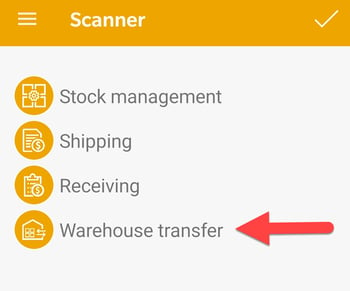
The Warehouse transfer mode is used to move product from one location to another. A location may include a store, vehicle such as a service or supply truck, or a warehouse. A transfer ticket barcode can be scanned to open a ticket.
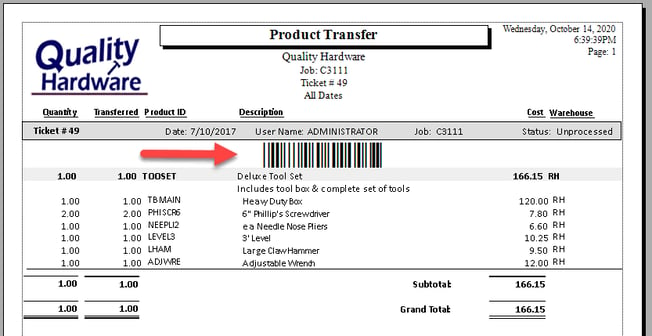
Scan or enter a sales order number and touch Open order icon ![]() to open an existing order. Tap the camera button
to open an existing order. Tap the camera button ![]() on the title bar to scan a barcode using the device's camera.
on the title bar to scan a barcode using the device's camera.
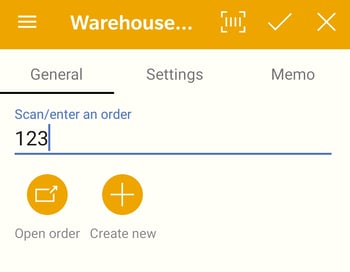
Tap the Create new button ![]() to create a new warehouse ticket.
to create a new warehouse ticket.
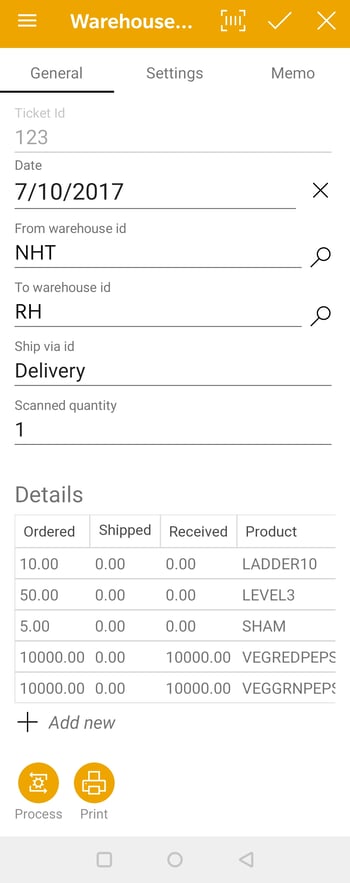
Set the Date used within the inventory transfer ticket.
Verify the source location (From warehouse) and the target location (To warehouse) of this product transfer ticket. The default settings of these twin warehouse settings are set within the Settings option as shown below.
Set the appropriate shipping method within the Ship Via setting that reflects the mode of the move of product.
Product can be scanned to entered into a transfer ticket by scanning a UPC code or a printed label. The quantity can be incremented by subsequent barcode scans or by adjusting the quantity. The quantities that are increased by this scanning action are determined by the user based Settings shown below:
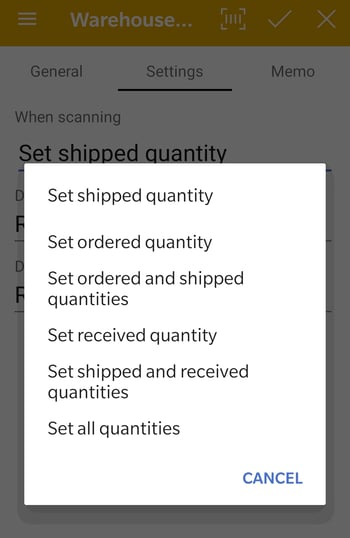
Set ordered and shipped quantity: Use this option at the shipping location in conjunction with E at the receiving location.
Set ordered quantity: Use this option at the shipping location in conjunction with D at the receiving location or by using the 3 step process described below:
Set shipped quantity: Use this option only for existing transfer tickets in a 3 step process described below.
Set shipped and received quantity: Use this option at the receiving location when B was used at the shipping location.
Set received quantity: Use this option at the receiving location when A was used at the shipping location or if the 3 step process described below is being used.
Set all quantities: Always use this option for the one step process described below.
Use the following settings based on the product transfer role and process used this warehouse transfer:
3 step process: The user that configure the MyInventory > Scanner > Warehouse Transfer > Settings with the F option listed above.
2 step process: The shipper at the original warehouse should use either the A or B option listed above, the receiver should use D (if the shipper used op0tion A) or E If the shipper used option B)
1 step process: The user should always use the F option listed above.
These settings are user based setting. Review Barcodes > Scanning Barcodes - Increment Counts within EBMS for default settings.
Tap Memo and dictate any notes into the inventory transfer > Memo within EBMS.
Tap Add new ![]() to add new products to the order.
to add new products to the order.
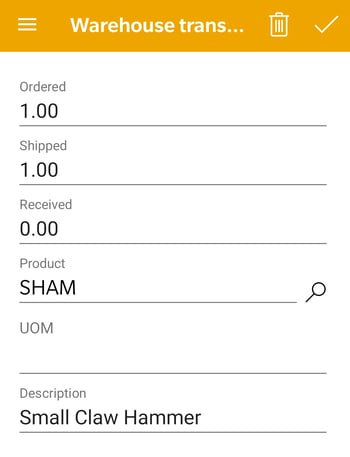
Enter Product IDs or scan the product's barcode as well as adjust the Ordered, Shipped and Received quantities. Tap save ![]() to add these items and return to the inventory transfer list.
to add these items and return to the inventory transfer list.

Tap Process to process the transfer ticket.
Tap Print to print the transfer ticket. This option will print the report that has been set in EBMS for the scanner. Review Configuring the Scanner in EBMS for instructions to set up the report.
Review Multiple Inventory Locations > Using Multiple Locations > Transferring Inventory to view this document within the EBMS software.
